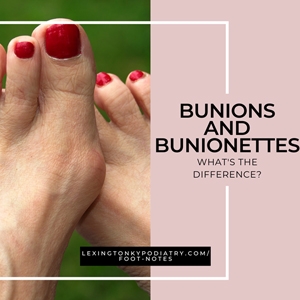If you have ever had a bunion, you may be wondering if a bunionette is the same thing. Do they both require surgery? Is there a way to treat them without surgery? Keep reading to learn more about bunions and bunionettes, including how to tell the difference between the two conditions.
The main difference is in location. Bunions are caused by the big toe pushing against your second toe, which then forces the joint of your big toe to become enlarged and deformed. Bunionettes, on the other hand, are caused by the fifth metatarsal bone pushing against your fourth toe, causing a bony bump on the outside of your foot.
Bunions tend to be more painful than bunionettes because they get much larger and can eventually cause your other toes to shift. When they become large enough, bunions rub against your shoes, leading to blisters, calluses, and even open sores.
If you’re dealing with bunions and bunionettes, you don’t have to suffer in silence. There are some things you can do to help ease the discomfort associated with these pesky foot issues.
The first step is deciding which type of treatment is best for you. Depending on the severity of your condition, you may need to visit a podiatrist and have surgery. If your bunions and bunionettes are mild, however, there are non-invasive treatments that can help.
One of the most popular treatments for bunions and bunionettes is custom orthotics. Orthotics provide arch support and cushioning to relieve pressure on the affected areas. They put your foot in proper alignment which slows the progression of bunions.
Another way to treat bunions and bunionettes is with the use of special padding and wraps. These are designed to cushion the area around the bunion, providing support and reducing pressure on the joint. We recommend using a bunion-met protection sleeve to provide your foot with cushioning and prevent it from rubbing against your shoes. It can be washed, reused, and fits easily into most shoes.
You can also try over-the-counter pain relievers, such as ibuprofen or aspirin, and icing the affected joint to reduce pain and inflammation. Topical anti-inflammatories, such as Mod Pod Soothe, are also very effective in reducing pain and inflammation. Soothe is a pain-relieving stick that contains 1000mg of CBD, arnica, eucalyptus, and lavender oils. This ultra-potent combination will reduce pain for a minimum of 4 hours. Soaking your feet in an Epsom salt soak called Relax will also help reduce inflammation.
So, there you have it. The lowdown on bunions and bunionettes. If you’re experiencing pain in your big toe joint, don’t suffer any longer – call us at 859-264-1141 or schedule an appointment online with our podiatrists today! We can help you get back to living your life without pain.

